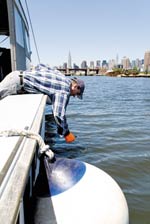 |

Update from Craig Michaels of Riverkeeper

Craig Michaels of Riverkeeper
|
 |
 |
April 21, 2009 — Riverkeeper initiated a citizen suit
in January 2004 against two of the world's largest oil companies for the largest urban oil spill —
right in the heart of New York City. In May 2004, Riverkeeper filed the lawsuit itself against
ExxonMobil for violation of the Clean Water Act and Resource Conservation and Recovery Act, Brooklyn
Borough President Marty Markowitz, and NYC Councilmembers David Yassky and Eric Gioia have joined
the case as co-plaintiffs. In 2007, New York State Attorney General Andrew Cuomo initiated a suit
against ExxonMobil on behalf of New York State.
 | 
John Lipscomb, patrol boat captain for Hudson Riverkeeper, takes a sample to test
the polluted waters of Newtown Creek. Photo by Giles Ashford.
|
 |
For more than half a century, millions of gallons of oil have been oozing
beneath Greenpoint, Brooklyn, courtesy of ExxonMobil and other oil companies. The spill courses
beneath 55 acres of industrial, commercial and residential property, affecting 100 homes and dozens
of businesses. Petroleum from the spill continuously leaks into Newtown Creek; globs of oil and a
rainbow sheen constantly coat the surface of this small waterway separating Brooklyn and Queens. The
spill — 50 percent larger than the Exxon Valdez disaster — is a major source of
contamination throughout the New York Harbor. Carcinogens, lead, and a bevy of other toxins are
carried for miles with the tides and currents. Though discovered 25 years ago and brought under
state enforcement in 1990, remedial efforts have been a failure and the companies continue to
violate federal law.
"The U.S. Environmental Protection Agency is now considering listing Newtown Creek
as a federal Superfund site."

Garbage along Newtown Creek
|
 |
 |
Newtown Creek is still considered to be one of the most polluted waterways in
the country, along with other New York City waterways such as the Gowanus Canal. The U.S.
Environmental Protection Agency is now considering listing Newtown Creek as a federal Superfund
site. EPA has recently concluded its sediment sampling program in the creek and will likely make a
determination within the next year. The agency has already proposed listing the Gowanus Canal as a
Superfund site and is now accepting public comments on the proposal.
Another problem plaguing these waterways are combined sewer overflows, or CSOs.
Because of an outmoded and overburdened sewer system, New York City releases over 27 billion gallons
of raw sewage into New York Harbor every year. Ten percent of that waste (2.7 billion gallons)
flows directly into Newtown Creek.
Watch a video about Newtown Creek.
Read the original 2004 story about
Newtown Creek.
Recent articles & blog posts on the subject:
Gowanus
Canal in Brooklyn Is Given Superfund Status
The New York Times,
March 2, 2010
As
Sewers Fill, Waste Poisons Waterways
The New York Times,
November 22, 2009
Feds mulling Superfund Status for Newtown
Creek
NY Daily News,
April 21, 2009
EPA Weighs
in on Gowanus Canal Superfund designation
NY Daily News,
April 16, 2009
Gowanus
Developer to Pull Out if EPA Designates Polluted Canal a Superfund site
NY Daily News,
April 10, 2009
George Trakas at the Water's Edge: Newtown Creek
Urban Omnibus Blog

We want to hear your thoughts on the issues. How do you relate to your environment? Do you
know your local waterways as well as you know the roads? Share your story with us, and see what
others have to say.
|
Related Links
Riverkeeper
East River
Apprenticeshop
 |
 |
